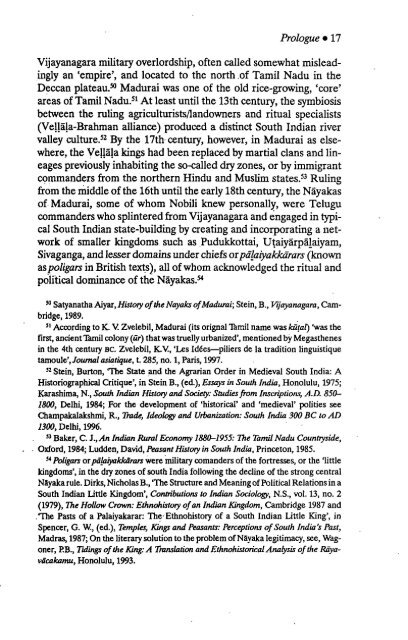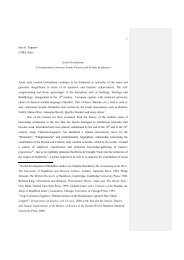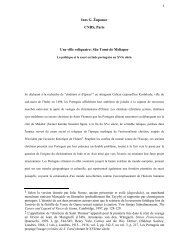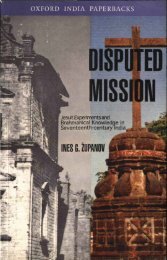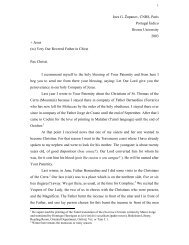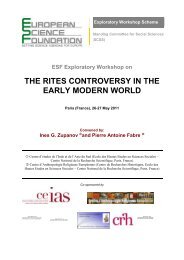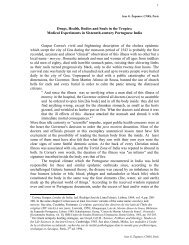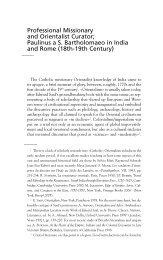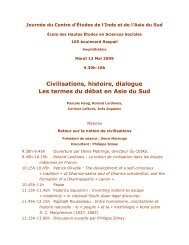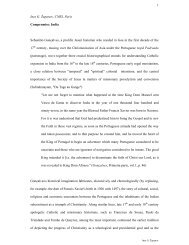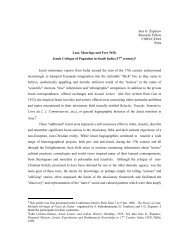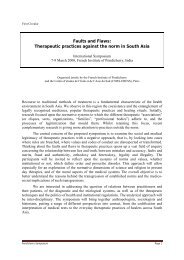INES G. ZUPANOV - Ines G. Županov
INES G. ZUPANOV - Ines G. Županov
INES G. ZUPANOV - Ines G. Županov
Create successful ePaper yourself
Turn your PDF publications into a flip-book with our unique Google optimized e-Paper software.
Prologue • 17<br />
Vijayanagara military overlordship, often called somewhat misleadingly<br />
an 'empire', and located to the north of Tamil Nadu in the<br />
Deccan plateau. 50 Madurai was one of the old rice-growing, 'core'<br />
areas of Tamil Nadu. 51 At least until the 13th century, the symbiosis<br />
between the ruling agriculturists/landowners and ritual specialists<br />
(VeUäja-Brahman alliance) produced a distinct South Indian river<br />
valley culture. 52 By the 17th century, however, in Madurai as elsewhere,<br />
the Velläla kings had been replaced by martial clans and lineages<br />
previously inhabiting the so-called dry zones, or by immigrant<br />
commanders from the northern Hindu and Muslim states. 53 Ruling<br />
from the middle of the 16th until the early 18th century, the Nâyakas<br />
of Madurai, some of whom Nobili knew personally, were Telugu<br />
commanders who splintered from Vijayanagara and engaged in typical<br />
South Indian state-building by creating and incorporating a network<br />
of smaller kingdoms such as Pudukkottai, Utaiyärpälaiyam,<br />
Sivaganga, and lesser domains under chiefs orpähziyakkärars (known<br />
aspoligars in British texts), all of whom acknowledged the ritual and<br />
political dominance of the Näyakas. 54<br />
50 Satyanatha Aiyar, History of the Nayaks of Madurai; Stein, B., Vijayanagara, Cambridge,<br />
1989.<br />
31 According to K. V Zvelebil, Madurai (its orignal Tamil name was kütat) 'was the<br />
first, ancient Tamil colony (ür) that was tmelly urbanized', mentioned by Megasthenes<br />
in the 4th century BC. Zvelebil, K.V, 'Les Idées—piliers de la tradition linguistique<br />
tamoule', Journal asiatique, t. 285, no. 1, Paris, 1997.<br />
32 Stein, Burton, 'The State and the Agrarian Order in Medieval South India: A<br />
Historiographical Critique', in Stein B., (ed.), Essays in South India, Honolulu, 1975;<br />
Karashima, N., South Indian History and Society: Studies from Inscriptions, A.D. 850-<br />
1800, Delhi, 1984; For the development of 'historical' and 'medieval' polities see<br />
Champakalakshmi, R., Trade, Ideology and Urbanization: South India 300 BC to AD<br />
1300, Delhi, 1996.<br />
.<br />
n Baker, C. J., An Indian Rural Economy 1880-1955: The Tamil Nadu Countryside,<br />
Oxford, 1984; Ludden, David, Peasant History in South India, Princeton, 1985.<br />
34 Poligoni orpâlaiyakkârars were military comanders of the fortresses, or the 'little<br />
kingdoms', in the dry zones of south India following the decline of the strong central<br />
Nayaka rule. Dirks, Nicholas B., 'The Structure and Meaning of Political Relations in a<br />
South Indian Little Kingdom', Contributions to Indian Sociology, N.S., vol. 13, no. 2<br />
(1979), The Hollow Crown: Ethnohistory of an Indian Kingdom, Cambridge 1987 and<br />
.'The Pasts of a Palaiyakarar: TheEthnohistory of a South Indian Little King', in<br />
Spencer, G. W., (ed.), Temples, Kings and Peasants: Perceptions of South India's Past,<br />
Madras, 1987; On the literary solution to the problem of Nayaka legitimacy, see, Wagoner,<br />
P.B., Tidings of the King: A Translation and Ethnohistorical Analysis of the Räyavâcakamu,<br />
Honolulu, 1993.


